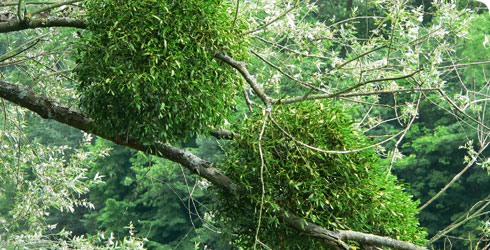Biology
Mistletoe belongs to a group of plants referred to as hemi-parasites ('hemi' meaning partial).
Full parasites take all their nutritional requirements from their host, and hemi-parasites act in the same way until they are fully established. However, hemi-parasites produce green stems and leaves and are therefore capable of photosynthesising at least some of their own food in the same way as non-parasitic plants.
Mistletoe manufactures the majority of its own food, taking only water and minerals from the host. Other species produce only a small proportion of the sugars they require, taking the rest from the host.
Mistletoe berries are attractive to birds such as the mistle thrush but contain very sticky tissue called viscin which makes the seed difficult to swallow. The bird rids itself of the sticky seed by wiping its beak against the bark of a tree. The viscin hardens and glues the seed to the tree branch.
When the tree is a suitable host species, the mistletoe seed forms a swollen holdfast. The stem and special root-like organs called haustora grow out from the holdfast. The haustorium penetrates the host tissue, entering the vascular system which transports water around the host body, allowing the mistletoe plant access to a constant supply.
Mistletoes are very highly adapted to this lifestyle. The germinating seeds of 1 species, Loranthus globosus are even claimed to ‘walk’ along a tree branch by flipping end over end until they become successfully wedged into the bark.
